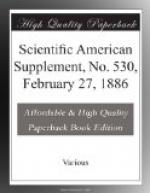* * * * *
Papier mache has come of late to be largely used in the manufacture of theatrical properties, and nearly all the magnificent vases, the handsome plaques, the graceful statues, and the superb gold and silver plate seen to-day on the stage are made of that material.
* * * * *
CEMENT PAVING.
The streets of “Old London” at the recent Inventions Exhibition at South Kensington were paved with a material in imitation of old, worn bowlder stones and red, herring-boned brickwork, all in one piece from one side of the street to the other. The composition is made by Wilkes’ Metallic Flooring Company, out of a mixture consisting chiefly of iron slag and Portland cement, a compound possessing properties which won the only gold medal given for paving at that Exhibition. At the present time the colonnade in Pall Mall, near Her Majesty’s Theater, is being laid with this paving, which is also being extensively used in London and the provinces for roads, tramways, and flooring; the composition is likewise sometimes cast into artistic forms for the ornamentation of buildings, or into slabs for roofing, facing, and other purposes. The subway from the Exhibition to the District Railway is laid with the same material.
The works of the Wilkes Metallic Flooring Company are in the goods yard of the Midland Railway Company at West Kensington. The Portland cement, before it is accepted at the works, is tested by means of an Aidie’s machine. The general strain the set cement is required to bear is 750 lb. to the square inch. All samples which will not bear a strain of 500 lb. are rejected. The various iron slags are carefully selected, and rejected when too soft, and at the works a small percentage of black slag, rich in iron, is mixed in with them. The lumps of slag are first crushed in a Mason & Co.’s stone breaker, and then sifted through 1/8 in., 1/4 in., and 1/16 in. wire meshes into these three sizes for mixing. Next the granulated substance is thoroughly well washed with water to remove soluble matter and impalpable dust, and afterward placed where it is protected from the access of dust and dirt. The washing waters carry off some sulphides, as well as mechanical impurities. The Portland cement is not used just as it, comes from the works, but is exposed to the air in a drying room for about fourteen days, and turned over two or three times during that period. The slag is also turned over three times dry and three times wet, and mixed with the Portland cement by means of water containing 5 per cent. of “Reekie” cement to make the whole mass set quickly. The mixture is then turned over twice and put into moulds; each mould is first half filled, and the mixture then hammered down with iron beaters. The rest of the composition is then poured in, beaten down, and the whole mould violently jolted




